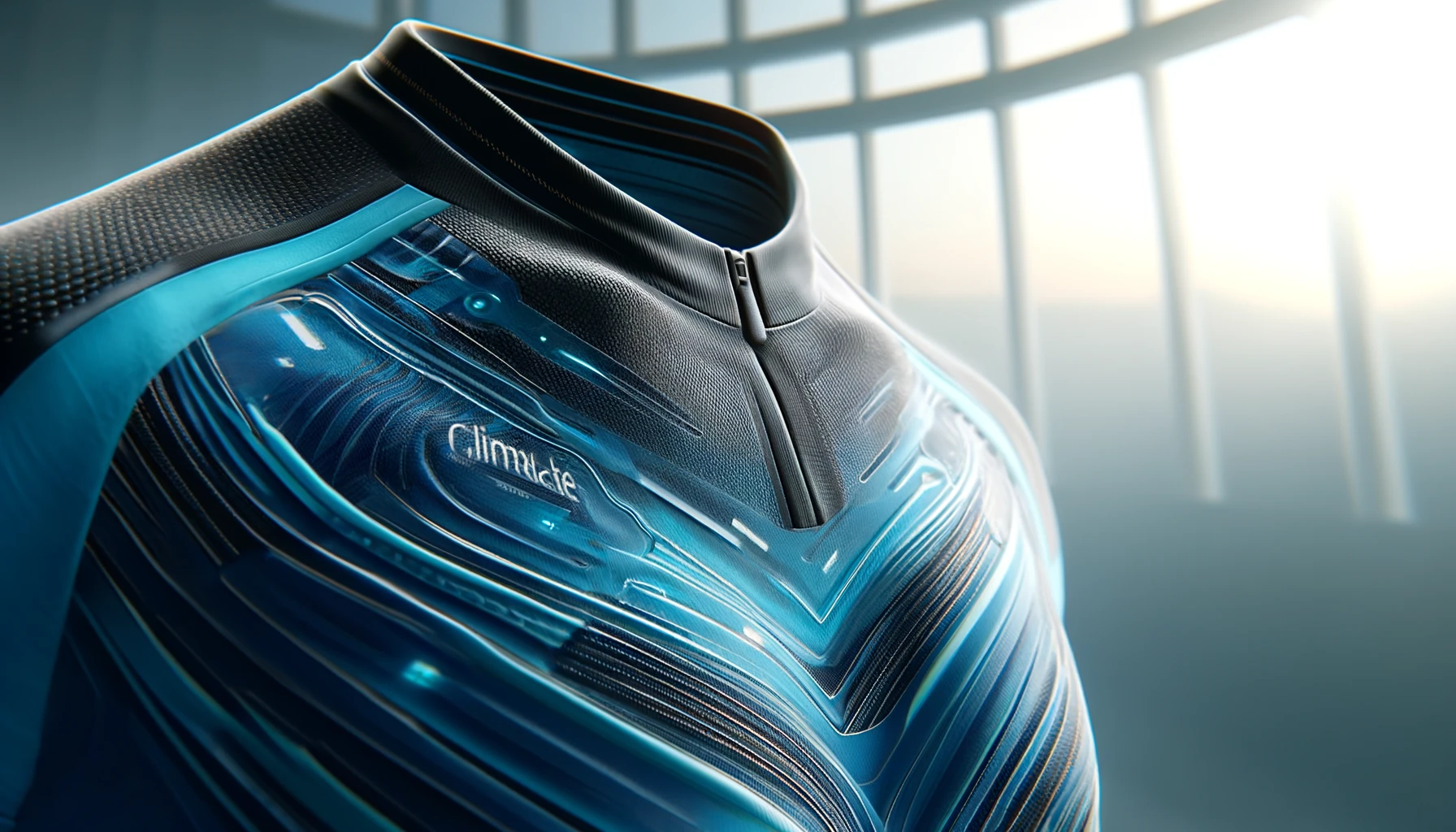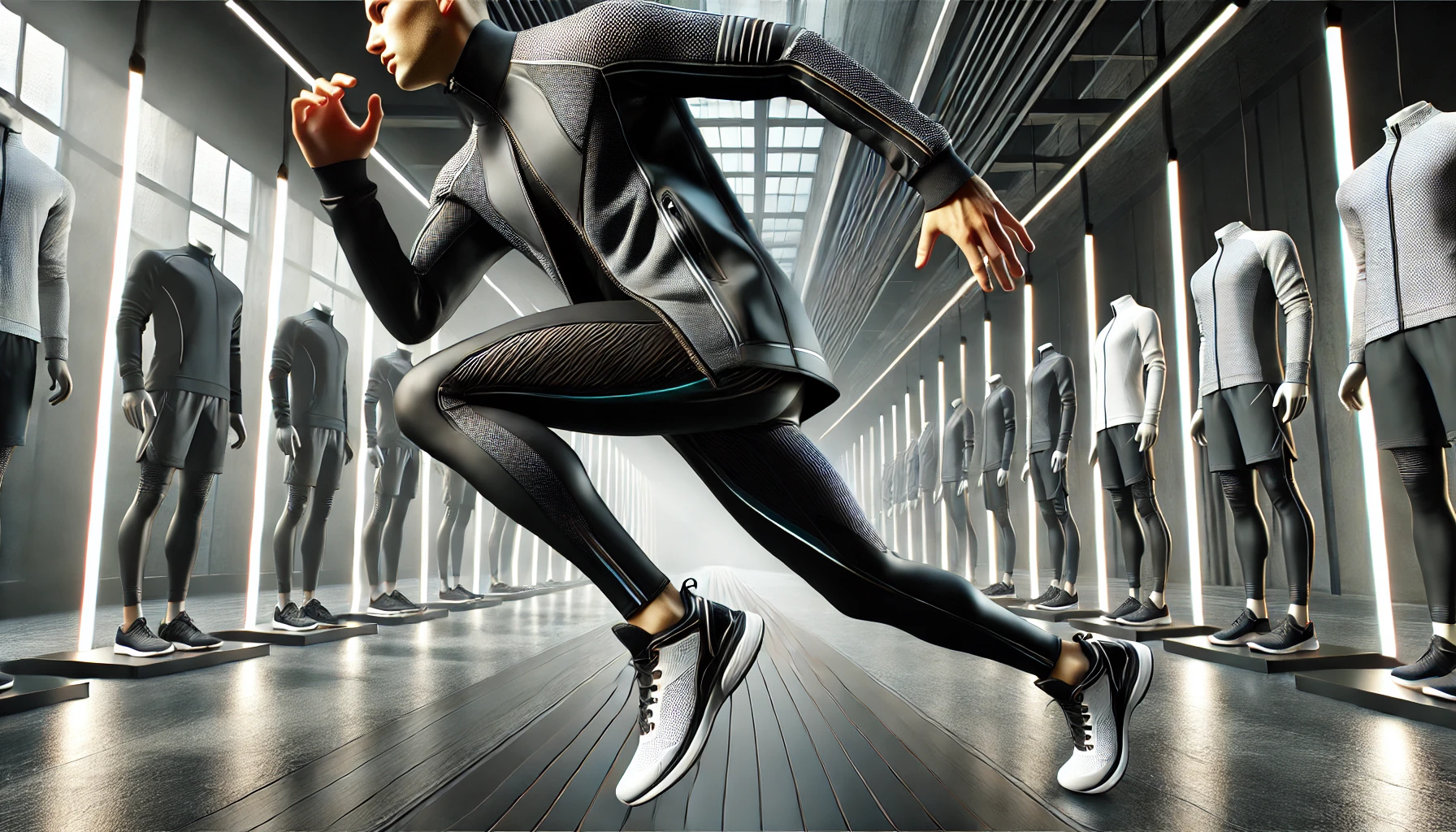Engineering Performance: How High-Tech Fabrics Transform Athletic Apparel
Athletic apparel has come a long way from the simple cotton t-shirts and shorts that athletes once wore. Today, high-performance sports gear is designed with advanced fabrics that improve an athlete's performance, comfort, and safety. This article will explore how high-tech materials are revolutionizing athletic apparel, focusing on some of the most popular materials used in the industry.
Moisture Management and Temperature Regulation
The ability to manage moisture and regulate body temperature is crucial for athletes, as it can greatly impact performance and comfort. Due to this, several high-tech fabrics have been developed to meet these needs, making them an essential component of modern sports gear.

Dri-FIT: Staying Dry and Comfortable
Developed by Nike, Dri-FIT is one of the most well-known moisture-wicking fabrics in the world of athletic apparel. Dri-FIT works by pulling sweat away from the skin to the fabric's surface, where it can evaporate quickly. This process helps keep athletes dry and comfortable, even during intense workouts.
The fabric's effectiveness is due to its unique blend of polyester microfibers, which enhance capillary action. This enables the fabric to quickly absorb moisture, reducing the chance of chafing and irritation. Dri-FIT fabric is commonly used in athletic garments such as shirts, shorts, and socks, making it a popular choice among athletes in various sports.
Climalite: Regulating Body Temperature
Adidas' Climalite fabric is another key player in the realm of moisture management. Similar to Dri-FIT, Climalite wicks moisture away from the skin, but it also has the added benefit of regulating body temperature. This dual functionality helps athletes stay cool and dry, particularly in warm conditions.
Climalite fabrics are made from a blend of polyester and other synthetic materials, which provide a lightweight and breathable feeling. The fabric's unique design allows for optimal air flow, helping to dissipate heat and keep the body at a comfortable temperature. This makes Climalite ideal for outdoor sports and intense activities.
Coolmax: Advanced Moisture Wicking
Coolmax, developed by Invista, is another fabric designed to manage moisture and regulate body temperature. Coolmax's structure consists of specially engineered polyester fibers that create a larger surface area for moisture to evaporate. This advanced moisture-wicking capability ensures that athletes remain cool and dry during physical exertion.
One of the standout features of Coolmax is its versatility. The fabric is used in a wide range of athletic apparel, from running shirts and cycling jerseys to hiking socks and underwear. Its ability to keep athletes comfortable in various conditions has made Coolmax a favorite among outdoor enthusiasts and professional athletes alike.
Thermoregulation: Year-Round Comfort
Thermoregulation fabrics are designed to keep athletes comfortable in both hot and cold conditions. These fabrics work by adjusting their properties based on the external environment and the body's needs, ensuring optimal temperature regulation.
In hot conditions, thermoregulation fabrics enhance breathability and moisture wicking, helping to cool the body. In cold conditions, they provide insulation by trapping heat close to the skin. This adaptability makes thermoregulation fabrics ideal for athletes who train and compete year-round, as they can rely on their apparel to provide consistent comfort regardless of the weather.
Stretch: Freedom of Movement
Flexibility and freedom of movement are crucial for athletes, as they need to perform a wide range of motions without restriction. Stretch fabrics, made from materials like spandex and elastane, provide the necessary flexibility to accommodate these movements.
Stretch fabrics are designed to move with the body, offering a snug yet flexible fit. This elasticity allows athletes to perform dynamic movements, such as jumping, stretching, and sprinting, without feeling constrained by their clothing. Additionally, stretch fabrics retain their shape well, ensuring that the garment continues to fit properly even after repeated use.
Quick-Dry: Reducing Discomfort
Quick-dry fabrics are engineered to dry rapidly, minimizing the risk of chafing and discomfort during exercise. These fabrics are particularly beneficial for athletes who engage in activities that involve water or excessive sweating, such as swimming, triathlons, or high-intensity interval training.
The quick-dry property is achieved through the use of hydrophobic fibers, which repel water and facilitate faster evaporation. This ensures that the garment dries quickly after being exposed to moisture, keeping the athlete comfortable and focused on their performance.
Breathable: Enhancing Airflow
Breathable fabrics are essential for maintaining comfort during physical activity, as they allow for proper airflow and moisture transfer. These fabrics are designed with a porous structure that enables air to circulate freely, preventing overheating and ensuring that sweat can evaporate efficiently.
Breathable fabrics are often used in combination with other high-tech materials to create athletic apparel that offers comprehensive moisture management and temperature regulation. This combination ensures that athletes remain cool, dry, and comfortable, even during prolonged periods of exercise.
Water-Repellent: Protection from the Elements
Water-repellent fabrics are designed to keep athletes dry in wet conditions, making them ideal for outdoor sports and activities. These fabrics are treated with a durable water repellent (DWR) finish that causes water to bead up and roll off the surface, preventing it from soaking into the garment.
Water-repellent fabrics are commonly used in jackets, pants, and other outerwear designed for activities such as running, cycling, and hiking. By keeping athletes dry, these fabrics help maintain comfort and prevent the chilling effects of wet clothing.
Antimicrobial: Staying Fresh and Clean
Athletic apparel can quickly become a breeding ground for bacteria and odor-causing microorganisms, especially after intense workouts. Antimicrobial fabrics are treated with agents that inhibit the growth of these microorganisms, keeping the garment fresh and clean for longer periods.
The use of antimicrobial fabrics is particularly beneficial in items like socks, base layers, and compression gear, which are worn close to the skin and are prone to odor buildup. By preventing bacterial growth, these fabrics enhance hygiene and extend the lifespan of the garment.
Smart Fabric: Real-Time Performance Feedback
The latest innovation in high-tech athletic fabrics is the development of smart fabrics, which incorporate sensors to provide real-time feedback on an athlete's performance. These fabrics can monitor various metrics, such as heart rate, temperature, and muscle activity, and transmit the data to a connected device for analysis.
Smart fabrics are designed to be lightweight and comfortable, integrating seamlessly into athletic apparel without hindering movement. The real-time data they provide allows athletes to track their performance, identify areas for improvement, and optimize their training regimens.
Enhancing Performance and Comfort with High-Tech Fabrics
High-tech fabrics are engineered to provide athletes with the best possible performance and comfort during exercise. By integrating advanced materials and innovative technologies, these fabrics offer numerous benefits that go beyond traditional sportswear. In this section, we will delve into how these high-tech fabrics enhance performance and comfort, making them indispensable for athletes.
Maximizing Performance with Moisture Management
Proper moisture management is crucial for maintaining performance levels during physical activity. When athletes sweat, moisture can accumulate, leading to discomfort and potential performance decline. High-tech fabrics like Dri-FIT, Climalite, and Coolmax address this issue by efficiently wicking moisture away from the skin.
Dri-FIT: Keeping Athletes Dry
Nike’s Dri-FIT technology is designed to keep athletes dry and comfortable. The fabric’s ability to pull sweat away from the skin to the surface allows for quick evaporation, which is essential during intense workouts. This helps athletes maintain focus and energy levels, as they are not distracted by the discomfort of wet clothing.
Dri-FIT is particularly beneficial for high-intensity sports such as running, basketball, and soccer, where players are likely to sweat heavily. By keeping the body dry, Dri-FIT helps regulate body temperature, preventing overheating and allowing athletes to perform at their peak.
Climalite: Regulating Temperature
Adidas’ Climalite fabric combines moisture-wicking properties with temperature regulation. The fabric’s ability to manage moisture and enhance airflow helps keep athletes cool and dry, especially in warm conditions. This dual functionality is particularly useful for outdoor sports and activities.
Climalite’s lightweight and breathable nature make it ideal for sports like tennis, cycling, and hiking, where maintaining a comfortable body temperature is crucial. The fabric’s effectiveness in regulating temperature ensures that athletes can sustain high performance without being hindered by heat and sweat.
Coolmax: Advanced Cooling
Coolmax, developed by Invista, takes moisture management to the next level with its advanced cooling capabilities. The fabric’s unique structure increases the surface area for moisture to evaporate, providing superior cooling and drying performance. This makes Coolmax an excellent choice for endurance sports and activities in hot climates.
Athletes wearing Coolmax apparel benefit from the fabric’s ability to keep them cool and dry during prolonged periods of exercise. Whether it’s a marathon, a long-distance bike ride, or an intense gym session, Coolmax helps maintain optimal body temperature and comfort.
Thermoregulation: Year-Round Comfort
Thermoregulation fabrics are designed to adapt to different environmental conditions, providing comfort throughout the year. These fabrics adjust their properties based on external temperatures, ensuring that athletes remain comfortable in both hot and cold weather.
Adaptive Insulation
In cold conditions, thermoregulation fabrics provide insulation by trapping heat close to the body. This is particularly beneficial for outdoor sports like skiing, snowboarding, and winter running, where maintaining body warmth is essential. The fabric’s ability to retain heat helps prevent hypothermia and keeps muscles warm, reducing the risk of injury.
Enhanced Breathability in Heat
In hot conditions, thermoregulation fabrics enhance breathability and moisture wicking, helping to cool the body. This is crucial for sports like beach volleyball, summer hiking, and desert running, where high temperatures can be challenging. The fabric’s breathability ensures that heat is dissipated efficiently, preventing overheating and allowing athletes to stay comfortable.
Flexibility and Freedom of Movement
High-tech fabrics are also designed to provide flexibility and freedom of movement, which are essential for athletic performance. Stretch fabrics, such as those containing spandex or elastane, offer the elasticity needed to accommodate a wide range of motions without restriction.
Stretch Fabrics: Enhancing Mobility
Stretch fabrics are engineered to move with the body, providing a snug yet flexible fit. This elasticity allows athletes to perform dynamic movements, such as jumping, stretching, and sprinting, without feeling constrained by their clothing. Stretch fabrics are commonly used in yoga wear, gymnastics leotards, and compression gear, where flexibility is paramount.
The ability of stretch fabrics to retain their shape ensures that the garment continues to fit properly even after repeated use. This durability makes stretch fabrics a reliable choice for athletes who require both performance and longevity from their sportswear.
Compression Garments: Supporting Performance
Compression garments, made from high-tech stretch fabrics, offer additional benefits by providing muscle support and enhancing circulation. These garments apply graduated pressure to specific muscle groups, reducing muscle vibration and fatigue during exercise. This can lead to improved performance and faster recovery times.
Compression wear is popular among runners, weightlifters, and basketball players, as it helps stabilize muscles and joints, reducing the risk of injury. The enhanced blood flow provided by compression garments also aids in the removal of metabolic waste products, promoting quicker recovery.
Quick-Dry Fabrics: Reducing Discomfort
Quick-dry fabrics are designed to dry rapidly, minimizing the risk of chafing and discomfort during exercise. These fabrics are particularly beneficial for athletes who engage in activities that involve water or excessive sweating.
Hydrophobic Fibers
Quick-dry fabrics use hydrophobic fibers that repel water, facilitating faster evaporation. This ensures that the garment dries quickly after being exposed to moisture, keeping the athlete comfortable and focused on their performance. Quick-dry fabrics are commonly used in swimwear, triathlon suits, and running gear, where staying dry is essential.
Breathable Fabrics: Enhancing Airflow
Breathable fabrics are essential for maintaining comfort during physical activity, as they allow for proper airflow and moisture transfer. These fabrics are designed with a porous structure that enables air to circulate freely, preventing overheating and ensuring that sweat can evaporate efficiently.
Optimized Ventilation
Breathable fabrics are often used in combination with other high-tech materials to create athletic apparel that offers comprehensive moisture management and temperature regulation. For example, breathable panels are often incorporated into running shirts and cycling jerseys to enhance ventilation in high-sweat areas. This combination ensures that athletes remain cool, dry, and comfortable, even during prolonged periods of exercise.
Protection from the Elements
Athletes who train and compete outdoors often face challenging weather conditions. High-tech fabrics provide essential protection from the elements, ensuring that athletes can perform at their best regardless of the environment.
Water-Repellent Fabrics
Water-repellent fabrics are treated with a durable water repellent (DWR) finish that causes water to bead up and roll off the surface, preventing it from soaking into the garment. This is particularly beneficial for sports like running, cycling, and hiking, where athletes may encounter rain or wet conditions.
By keeping athletes dry, water-repellent fabrics help maintain comfort and prevent the chilling effects of wet clothing. This protection is essential for maintaining performance and preventing hypothermia in cold, wet conditions.
Windproof Fabrics
Windproof fabrics are designed to block the wind, providing an additional layer of protection for athletes. These fabrics are commonly used in jackets, pants, and gloves designed for outdoor sports and activities. Windproof garments help retain body heat and prevent wind chill, ensuring that athletes stay warm and comfortable in blustery conditions.
Antimicrobial Fabrics: Staying Fresh and Clean
Antimicrobial fabrics are treated with agents that inhibit the growth of bacteria and odor-causing microorganisms. This technology is particularly beneficial for athletic apparel, which can quickly become a breeding ground for bacteria after intense workouts.
Enhanced Hygiene
The use of antimicrobial fabrics helps keep garments fresh and clean for longer periods, reducing the need for frequent washing. This is especially useful for items like socks, base layers, and compression gear, which are worn close to the skin. By preventing bacterial growth, antimicrobial fabrics enhance hygiene and extend the lifespan of the garment.
Smart Fabrics: Real-Time Performance Feedback
The latest innovation in high-tech athletic fabrics is the development of smart fabrics, which incorporate sensors to provide real-time feedback on an athlete’s performance. These fabrics can monitor various metrics, such as heart rate, temperature, and muscle activity, and transmit the data to a connected device for analysis.
Integrated Technology
Smart fabrics are designed to be lightweight and comfortable, integrating seamlessly into athletic apparel without hindering movement. The real-time data they provide allows athletes to track their performance, identify areas for improvement, and optimize their training regimens. This cutting-edge technology offers a personalized approach to athletic performance, helping athletes achieve their goals more efficiently.

The Future of High-Tech Fabrics in Sportswear
The evolution of high-tech fabrics in athletic apparel has already transformed the way athletes train and compete. However, innovation in this field is far from over. As technology advances, so does the potential for creating even more sophisticated materials that can further enhance performance, comfort, and health. In this final section, we will explore emerging trends and future possibilities for high-tech fabrics in sportswear.
Sustainable and Eco-Friendly Fabrics
One of the most significant trends in the development of high-tech fabrics is the focus on sustainability. With increasing awareness of environmental issues, both consumers and manufacturers are seeking ways to reduce the ecological impact of sportswear.
Recycled Materials
Many brands are now incorporating recycled materials into their high-tech fabrics. For instance, polyester made from recycled plastic bottles is becoming increasingly popular. This not only helps reduce waste but also conserves resources by minimizing the need for virgin materials.
Recycled polyester retains the moisture-wicking, quick-dry, and breathable properties of traditional polyester, making it an excellent choice for athletic apparel. By choosing recycled materials, brands can offer high-performance sportswear while promoting environmental responsibility.
Biodegradable Fabrics
The development of biodegradable fabrics represents another exciting advancement in sustainable sportswear. These fabrics are designed to break down naturally after their useful life, reducing landfill waste and environmental pollution. Innovations in this area include biodegradable polyester and nylon, which can decompose more quickly than conventional synthetic fibers.
Biodegradable fabrics maintain the performance characteristics required for athletic apparel, such as durability, stretch, and moisture management. As technology progresses, the availability and affordability of these eco-friendly options are likely to increase, making sustainable sportswear more accessible to consumers.
Smart Fabrics: The Next Generation
Smart fabrics are poised to revolutionize the sportswear industry by integrating advanced technology directly into the fabric. These fabrics can monitor an athlete’s biometrics in real-time, providing valuable data that can be used to optimize performance and prevent injuries.
Enhanced Sensor Integration
Future smart fabrics will feature even more sophisticated sensors that can monitor a wider range of metrics, including hydration levels, respiratory rate, and muscle fatigue. These sensors will be seamlessly woven into the fabric, ensuring that the garments remain comfortable and unobtrusive.
For example, a smart shirt equipped with advanced sensors could track an athlete’s hydration status during a marathon, alerting them when it’s time to drink water. This real-time feedback can help athletes maintain optimal hydration levels, enhancing performance and preventing dehydration.
Wireless Connectivity and Data Analytics
The integration of wireless connectivity and advanced data analytics will further enhance the capabilities of smart fabrics. Garments will be able to transmit data to mobile apps or cloud-based platforms, where sophisticated algorithms can analyze the information and provide actionable insights.
Athletes will benefit from personalized training plans based on their unique biometrics, helping them improve performance and reduce the risk of overtraining. Coaches and trainers will also be able to monitor their athletes’ progress remotely, offering guidance and adjustments in real-time.
Adaptive Fabrics: Responding to Environmental Conditions
Adaptive fabrics represent another frontier in high-tech sportswear. These fabrics can change their properties in response to environmental conditions, providing dynamic performance benefits.
Phase-Change Materials
Phase-change materials (PCMs) are an example of adaptive fabrics that can regulate temperature by absorbing, storing, and releasing heat. When an athlete becomes too warm, the PCM absorbs excess heat, providing a cooling effect. Conversely, when the temperature drops, the PCM releases stored heat, providing warmth.
PCMs are already being used in some athletic apparel, but future advancements will make these materials more efficient and widely available. This will enable athletes to maintain optimal body temperature across a broader range of conditions, enhancing comfort and performance.
Shape-Memory Polymers
Shape-memory polymers are another exciting development in adaptive fabrics. These materials can change their shape in response to external stimuli, such as temperature or moisture. For example, a jacket made from shape-memory polymers could automatically adjust its fit and ventilation based on the wearer’s body temperature and activity level.
This dynamic adjustability can provide athletes with customized comfort and performance benefits, reducing the need for multiple layers or garments. As research progresses, shape-memory polymers will likely become a key component of next-generation athletic apparel.
Antimicrobial and Anti-Odor Technologies
While antimicrobial fabrics are already a staple in high-tech sportswear, future advancements will enhance their effectiveness and durability. New antimicrobial treatments will offer longer-lasting protection against bacteria and odors, ensuring that garments remain fresh and hygienic even after extended use.
Nanotechnology
Nanotechnology is set to play a significant role in the development of more effective antimicrobial fabrics. By incorporating nanoparticles into the fabric, manufacturers can create garments with enhanced antimicrobial properties that are resistant to washing and wear.
For instance, silver nanoparticles are known for their powerful antimicrobial effects. Integrating these nanoparticles into athletic apparel can provide robust protection against bacteria and odors, keeping garments fresh and extending their lifespan.
Environmental and Health Considerations
Future antimicrobial treatments will also prioritize environmental and health considerations. Manufacturers will focus on developing non-toxic and biodegradable antimicrobial agents that do not harm the environment or pose health risks to consumers.
Customization and Personalization
The future of high-tech sportswear will also see a trend towards greater customization and personalization. Advances in manufacturing technologies, such as 3D printing and digital textile printing, will enable brands to create bespoke garments tailored to individual athletes’ needs and preferences.
Custom Fit and Design
3D printing technology allows for the creation of custom-fit athletic apparel that conforms precisely to an athlete’s body shape. This ensures optimal comfort, performance, and support. Additionally, digital textile printing enables personalized designs, allowing athletes to express their unique style through their sportswear.
On-Demand Manufacturing
On-demand manufacturing will revolutionize the sportswear industry by reducing waste and inventory costs. Athletes will be able to order custom garments that are produced and delivered quickly, minimizing the environmental impact of overproduction and unsold stock.
Conclusion: The Future is Bright for High-Tech Sportswear
The future of high-tech fabrics in sportswear is incredibly promising. As technology continues to advance, the potential for creating even more innovative and effective materials will grow. From sustainable and eco-friendly fabrics to smart textiles that provide real-time performance feedback, the possibilities are endless.
These advancements will not only enhance athletic performance and comfort but also contribute to a more sustainable and responsible sportswear industry. Athletes can look forward to wearing apparel that not only supports their physical endeavors but also aligns with their values and environmental concerns.
At PowerStride, we are committed to staying at the forefront of these innovations, offering our customers the latest and most advanced athletic apparel available. Whether you’re a professional athlete or a fitness enthusiast, our high-tech sportswear is designed to help you perform at your best while keeping you comfortable and protected.
Visit PowerStride today to explore our range of high-performance sportswear and discover how our advanced fabrics can transform your athletic experience. Join us in embracing the future of sportswear and take your performance to the next level.




